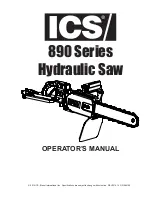
14
| English
2 609 932 557 • 30.11.06
d) Store idle power tools out of the reach of
children and do not allow persons unfa-
miliar with the power tool or these
instructions to operate the power tool.
Power tools are dangerous in the hands of
untrained users.
e) Maintain power tools. Check for misalign-
ment or binding of moving parts, break-
age of parts and any other condition that
may affect the power tool’s operation. If
damaged, have the power tool repaired
before use.
Many accidents are caused by
poorly maintained power tools.
f) Keep cutting tools sharp and clean.
Prop-
erly maintained cutting tools with sharp cutting
edges are less likely to bind and are easier to
control.
g) Use the power tool, accessories and tool
bits etc. in accordance with these instruc-
tions, taking into account the working
conditions and the work to be performed.
Use of the power tool for operations different
from those intended could result in a hazardous
situation.
5) Battery tool use and care
a) Recharge only with the charger specified
by the manufacturer.
A charger that is suita-
ble for one type of battery pack may create a
risk of fire when used with another battery
pack.
b) Use power tools only with specifically
designated battery packs.
Use of any other
battery packs may create a risk of injury and
fire.
c) When battery pack is not in use, keep it
away from other metal objects, like paper
clips, coins, keys, nails, screws or other
small metal objects, that can make a con-
nection from one terminal to another.
Shorting the battery terminals together may
cause burns or a fire.
d) Under abusive conditions, liquid may be
ejected from the battery; avoid contact. If
contact accidentally occurs, flush with
water. If liquid contacts eyes, additionally
seek medical help.
Liquid ejected from the
battery may cause irritation or burns.
6) Service
a) Have your power tool serviced by a quali-
fied repair person using only identical
replacement parts.
This will ensure that the
safety of the power tool is maintained.
Machine-specific
Safety Warnings
f
Keep hands away from the sawing range. Do
not reach under the workpiece.
Contact with
the saw blade can lead to injuries.
f
Apply the machine to the workpiece only
when switched on.
Otherwise there is danger of
kickback when the cutting tool jams in the work-
piece.
f
When sawing, the adjustable footplate 2
must always faces against the workpiece.
The saw blade can become wedged and lead to
loss of control over the machine.
f
When the cut is completed, switch off the
machine and then pull the saw blade out of
the cut only after it has come to a standstill.
In this manner you can avoid kickback and can
place down the machine securely.
f
Use only sharp, flawless saw blades.
Bent or
unsharp saw blades can break or cause kickback.
f
Do not brake the saw blade to a stop by
applying side pressure after switching off.
The saw blade can be damaged, break or cause
kickback.
f
Clamp material well. Do not support the
workpiece with your hand or foot. Do not
touch objects or the floor with the the saw
running.
Danger of kickback.
f
Use appropriate detectors to determine if
utility lines are hidden in the work area or
call the local utility company for assistance.
Contact with electric lines can lead to fire and
electric shock. Damaging a gas line can lead to
explosion. Penetrating a water line causes prop-
erty damage or may cause an electric shock.
f
Hold the machine only by the insulated grip-
ping surfaces, when performing an opera-
tion where the cutting tool may run into
hidden wiring.
Contact with a “live” wire will
make exposed metal parts of the tool “live” and
shock the operator.
f
When working with the machine, always
hold it firmly with both hands and provide for
a secure stance.
The power tool is guided more
secure with both hands.
f
Secure the workpiece.
A workpiece clamped
with clamping devices or in a vice is held more
secure than by hand.
f
Do not work materials containing asbestos.
Asbestos is considered carcinogenic.
f
Take protective measures when dust can
develop during working that is harmful to
one’s health, combustible or explosive.
Example: Some dusts are regarded as carcino-
genic. Wear a dust mask and work with dust/chip
extraction when connectable.
OBJ_BUCH-257-001.book Page 14 Thursday, November 30, 2006 3:06 PM















































